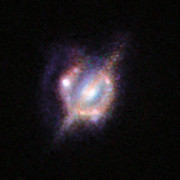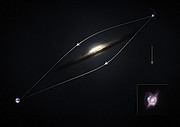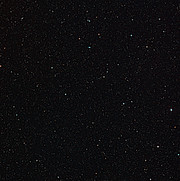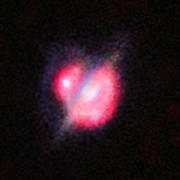Press Release
Best View Yet of Merging Galaxies in Distant Universe
ALMA applies methods of Sherlock Holmes
26 August 2014
Using the Atacama Large Millimeter/submillimeter Array (ALMA), and many other telescopes on the ground and in space, an international team of astronomers has obtained the best view yet of a collision that took place between two galaxies when the Universe was only half its current age. They enlisted the help of a galaxy-sized magnifying glass to reveal otherwise invisible detail. These new studies of the galaxy H-ATLAS J142935.3-002836 have shown that this complex and distant object looks like the well-known local galaxy collision, the Antennae Galaxies.
The famous fictional detective Sherlock Holmes used a magnifying lens to reveal barely visible but important evidence. Astronomers are now combining the power of many telescopes on Earth and in space [1] with a vastly larger form of cosmic lens to study a case of vigorous star formation in the early Universe.
“While astronomers are often limited by the power of their telescopes, in some cases our ability to see detail is hugely boosted by natural lenses, created by the Universe,” explains lead author Hugo Messias of the Universidad de Concepción (Chile) and the Centro de Astronomia e Astrofísica da Universidade de Lisboa (Portugal). “Einstein predicted in his theory of general relativity that, given enough mass, light does not travel in a straight line but will be bent in a similar way to light refracted by a normal lens.”
These cosmic lenses are created by massive structures like galaxies and galaxy clusters, which deflect the light from objects behind them due to their strong gravity — an effect, called gravitational lensing. The magnifying properties of this effect allow astronomers to study objects which would not be visible otherwise and to directly compare local galaxies with much more remote ones, seen when the Universe was significantly younger.
But for these gravitational lenses to work, the lensing galaxy, and the one far behind it, need to be very precisely aligned.
“These chance alignments are quite rare and tend to be hard to identify,” adds Hugo Messias, “but, recent studies have shown that by observing at far-infrared and millimetre wavelengths we can find these cases much more efficiently.”
H-ATLAS J142935.3-002836 (or just H1429-0028 for short) is one of these sources and was found in the Herschel Astrophysical Terahertz Large Area Survey (H-ATLAS). Although very faint in visible light pictures, it is among the brightest gravitationally lensed objects in the far-infrared regime found so far, even though we are seeing it at a time when the Universe was just half its current age.
Probing this object was at the limit of what is possible, so the international team of astronomers started an extensive follow-up campaign using the most powerful telescopes — both on the ground as well as in space — including the NASA/ESA Hubble Space Telescope, ALMA, the Keck Observatory, the Karl Jansky Very Large Array (JVLA), and others. The different telescopes provided different views, which could be combined to get the best insight yet into the nature of this unusual object.
The Hubble and Keck images revealed a detailed gravitationally-induced ring of light around the foreground galaxy. These high resolution images also showed that the lensing galaxy is an edge-on disc galaxy — similar to our galaxy, the Milky Way — which obscures parts of the background light due to the large dust clouds it contains.
But this obscuration is not a problem for ALMA and the JVLA, since these two facilities observe the sky at longer wavelengths, which are unaffected by dust. Using the combined data the team discovered that the background system was actually an ongoing collision between two galaxies. From this point on, ALMA and the JVLA started to play a key role in further characterising this object.
In particular, ALMA traced carbon monoxide, which allows detailed studies of star formation mechanisms in galaxies. The ALMA observations also allowed the motion of the material in the more distant object to be measured. This was essential to show that the lensed object is indeed an ongoing galactic collision forming hundreds of new stars each year, and that one of the colliding galaxies still shows signs of rotation; an indication that it was a disc galaxy just before this encounter.
The system of these two colliding galaxies resembles an object that is much closer to us: the Antennae Galaxies. This is a spectacular collision between two galaxies, which are believed to have had a disc structure in the past. While the Antennae system is forming stars at a rate of only a few tens of the mass of our Sun each year, H1429-0028 turns more than 400 times the mass of the Sun of gas into new stars each year.
Rob Ivison, ESO’s Director of Science and a co-author of the new study, concludes: “ALMA enabled us to solve this conundrum because it gives us information about the velocity of the gas in the galaxies, which makes it possible to disentangle the various components, revealing the classic signature of a galaxy merger. This beautiful study catches a galaxy merger red handed as it triggers an extreme starburst.”
Notes
[1] Among the armada of instruments that were used to provide evidence to help unravel the mysteries of this case were no fewer than three ESO telescopes — ALMA, APEX and VISTA. The other telescopes and surveys that were brought to bear were: the NASA/ESA Hubble Space Telescope, the Gemini South telescope, the Keck-II telescope, the NASA Spitzer Space Telescope, the Jansky Very Large Array, CARMA, IRAM and SDSS and WISE.
More information
The Atacama Large Millimeter/submillimeter Array (ALMA), an international astronomy facility, is a partnership of Europe, North America and East Asia in cooperation with the Republic of Chile. ALMA is funded in Europe by the European Southern Observatory (ESO), in North America by the U.S. National Science Foundation (NSF) in cooperation with the National Research Council of Canada (NRC) and the National Science Council of Taiwan (NSC) and in East Asia by the National Institutes of Natural Sciences (NINS) of Japan in cooperation with the Academia Sinica (AS) in Taiwan. ALMA construction and operations are led on behalf of Europe by ESO, on behalf of North America by the National Radio Astronomy Observatory (NRAO), which is managed by Associated Universities, Inc. (AUI) and on behalf of East Asia by the National Astronomical Observatory of Japan (NAOJ). The Joint ALMA Observatory (JAO) provides the unified leadership and management of the construction, commissioning and operation of ALMA.
This research was presented in a paper entitled “Herschel-ATLAS and ALMA HATLAS J142935.3-002836, a lensed major merger at redshift 1.027”, by Hugo Messias et al., to appear online on 26 August 2014 in the journal Astronomy & Astrophysics.
The team is composed of Hugo Messias (Universidad de Concepción, Barrio Universitario, Chile; Centro de Astronomia e Astrofísica da Universidade de Lisboa, Portugal), Simon Dye (School of Physics and Astronomy, University of Nottingham, UK), Neil Nagar (Universidad de Concepción, Barrio Universitario, Chile), Gustavo Orellana (Universidad de Concepción, Barrio Universitario, Chile), R. Shane Bussmann (Harvard-Smithsonian Center for Astrophysics, USA), Jae Calanog (Department of Physics & Astronomy, University of California, USA), Helmut Dannerbauer (Universität Wien, Institut für Astrophysik, Austria), Hai Fu (Astronomy Department, California Institute of Technology, USA), Edo Ibar (Pontificia Universidad Católica de Chile, Departamento de Astronomía y Astrofísica, Chile), Andrew Inohara (Department of Physics & Astronomy, University of California, USA), R. J. Ivison (Institute for Astronomy, University of Edinburgh, Royal Observatory, UK; ESO, Garching, Germany), Mattia Negrello (INAF, Osservatorio Astronomico di Padova, Italy), Dominik A. Riechers (Astronomy Department, California Institute of Technology, USA; Department of Astronomy, Cornell University, USA), Yun-Kyeong Sheen (Universidad de Concepción, Barrio Universitario, Chile), Simon Amber (The Open University, Milton Keynes, UK), Mark Birkinshaw (H. H. Wills Physics Laboratory, University of Bristol, UK; Harvard-Smithsonian Center for Astrophysics, USA), Nathan Bourne (School of Physics and Astronomy, University of Nottingham, UK), Dave L. Clements (Astrophysics Group, Imperial College London, UK), Asantha Cooray (Department of Physics & Astronomy, University of California, USA; Astronomy Department, California Institute of Technology, USA), Gianfranco De Zotti (INAF, Osservatorio Astronomico di Padova, Italy), Ricardo Demarco (Universidad de Concepción, Barrio Universitario, Chile), Loretta Dunne (Department of Physics and Astronomy, University of Canterbury, New Zealand; Institute for Astronomy, University of Edinburgh, Royal Observatory, UK), Stephen Eales (School of Physics and Astronomy, Cardiff University,UK), Simone Fleuren (School of Mathematical Sciences, University of London, UK), Roxana E. Lupu (Department of Physics and Astronomy, University of Pennsylvania, USA), Steve J. Maddox (Department of Physics and Astronomy, University of Canterbury, New Zealand; Institute for Astronomy, University of Edinburgh, Royal Observatory, UK), Michał J. Michałowski (Institute for Astronomy, University of Edinburgh, Royal Observatory, UK), Alain Omont (Institut d’Astrophysique de Paris, UPMC Univ. Paris, France), Kate Rowlands (School of Physics & Astronomy, University of St Andrews, UK), Dan Smith (Centre for Astrophysics Research, Science & Technology Research Institute, University of Hertfordshire, UK), Matt Smith (School of Physics and Astronomy, Cardiff University,UK) and Elisabetta Valiante (School of Physics and Astronomy, Cardiff University, UK).
ESO is the foremost intergovernmental astronomy organisation in Europe and the world’s most productive ground-based astronomical observatory by far. It is supported by 15 countries: Austria, Belgium, Brazil, Czechia, Denmark, France, Finland, Germany, Italy, the Netherlands, Portugal, Spain, Sweden, Switzerland and the United Kingdom. ESO carries out an ambitious programme focused on the design, construction and operation of powerful ground-based observing facilities enabling astronomers to make important scientific discoveries. ESO also plays a leading role in promoting and organising cooperation in astronomical research. ESO operates three unique world-class observing sites in Chile: La Silla, Paranal and Chajnantor. At Paranal, ESO operates the Very Large Telescope, the world’s most advanced visible-light astronomical observatory and two survey telescopes. VISTA works in the infrared and is the world’s largest survey telescope and the VLT Survey Telescope is the largest telescope designed to exclusively survey the skies in visible light. ESO is the European partner of a revolutionary astronomical telescope ALMA, the largest astronomical project in existence. ESO is currently planning the 39-metre European Extremely Large optical/near-infrared Telescope, the E-ELT, which will become “the world’s biggest eye on the sky”.
Links
- Research paper
- More about ALMA
- Photos of ALMA
- Videos of ALMA
- ALMA brochure
- The movie ALMA — In Search of our Cosmic Origins
- The ALMA Photo Book In Search of our Cosmic Origins – The Construction of the Atacama Large Millimeter/submillimeter Array
- More press releases with ALMA
Contacts
Hugo Messias
Universidad de Concepción, Chile / Centro de Astronomia e Astrofísica da Universidade de Lisboa, Portugal
Tel: +351 21 361 67 47/30
Email: hmessias@oal.ul.pt
Richard Hook
ESO, Public Information Officer
Garching bei München, Germany
Tel: +49 89 3200 6655
Cell: +49 151 1537 3591
Email: rhook@eso.org
About the Release
| Release No.: | eso1426 |
| Name: | H-ATLAS J142935.3-002836 |
| Type: | Early Universe : Galaxy : Type : Gravitationally Lensed |
| Facility: | Atacama Large Millimeter/submillimeter Array, Atacama Pathfinder Experiment, CARMA, Gemini Observatory, Hubble Space Telescope, Spitzer Space Telescope, Visible and Infrared Survey Telescope for Astronomy |
| Science data: | 2014A&A...568A..92M |
Our use of Cookies
We use cookies that are essential for accessing our websites and using our services. We also use cookies to analyse, measure and improve our websites’ performance, to enable content sharing via social media and to display media content hosted on third-party platforms.
ESO Cookies Policy
The European Organisation for Astronomical Research in the Southern Hemisphere (ESO) is the pre-eminent intergovernmental science and technology organisation in astronomy. It carries out an ambitious programme focused on the design, construction and operation of powerful ground-based observing facilities for astronomy.
This Cookies Policy is intended to provide clarity by outlining the cookies used on the ESO public websites, their functions, the options you have for controlling them, and the ways you can contact us for additional details.
What are cookies?
Cookies are small pieces of data stored on your device by websites you visit. They serve various purposes, such as remembering login credentials and preferences and enhance your browsing experience.
Categories of cookies we use
Essential cookies (always active): These cookies are strictly necessary for the proper functioning of our website. Without these cookies, the website cannot operate correctly, and certain services, such as logging in or accessing secure areas, may not be available; because they are essential for the website’s operation, they cannot be disabled.
Functional Cookies: These cookies enhance your browsing experience by enabling additional features and personalization, such as remembering your preferences and settings. While not strictly necessary for the website to function, they improve usability and convenience; these cookies are only placed if you provide your consent.
Analytics cookies: These cookies collect information about how visitors interact with our website, such as which pages are visited most often and how users navigate the site. This data helps us improve website performance, optimize content, and enhance the user experience; these cookies are only placed if you provide your consent. We use the following analytics cookies.
Matomo Cookies:
This website uses Matomo (formerly Piwik), an open source software which enables the statistical analysis of website visits. Matomo uses cookies (text files) which are saved on your computer and which allow us to analyze how you use our website. The website user information generated by the cookies will only be saved on the servers of our IT Department. We use this information to analyze www.eso.org visits and to prepare reports on website activities. These data will not be disclosed to third parties.
On behalf of ESO, Matomo will use this information for the purpose of evaluating your use of the website, compiling reports on website activity and providing other services relating to website activity and internet usage.
Matomo cookies settings:
Additional Third-party cookies on ESO websites: some of our pages display content from external providers, e.g. YouTube.
Such third-party services are outside of ESO control and may, at any time, change their terms of service, use of cookies, etc.
YouTube: Some videos on the ESO website are embedded from ESO’s official YouTube channel. We have enabled YouTube’s privacy-enhanced mode, meaning that no cookies are set unless the user actively clicks on the video to play it. Additionally, in this mode, YouTube does not store any personally identifiable cookie data for embedded video playbacks. For more details, please refer to YouTube’s embedding videos information page.
Cookies can also be classified based on the following elements.
Regarding the domain, there are:
- First-party cookies, set by the website you are currently visiting. They are stored by the same domain that you are browsing and are used to enhance your experience on that site;
- Third-party cookies, set by a domain other than the one you are currently visiting.
As for their duration, cookies can be:
- Browser-session cookies, which are deleted when the user closes the browser;
- Stored cookies, which stay on the user's device for a predetermined period of time.
How to manage cookies
Cookie settings: You can modify your cookie choices for the ESO webpages at any time by clicking on the link Cookie settings at the bottom of any page.
In your browser: If you wish to delete cookies or instruct your browser to delete or block cookies by default, please visit the help pages of your browser:
Please be aware that if you delete or decline cookies, certain functionalities of our website may be not be available and your browsing experience may be affected.
You can set most browsers to prevent any cookies being placed on your device, but you may then have to manually adjust some preferences every time you visit a site/page. And some services and functionalities may not work properly at all (e.g. profile logging-in, shop check out).
Updates to the ESO Cookies Policy
The ESO Cookies Policy may be subject to future updates, which will be made available on this page.
Additional information
For any queries related to cookies, please contact: pdprATesoDOTorg.
As ESO public webpages are managed by our Department of Communication, your questions will be dealt with the support of the said Department.







